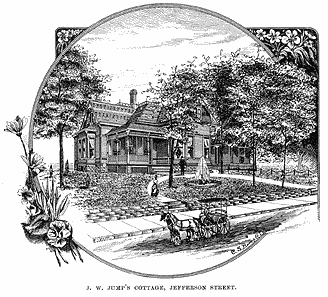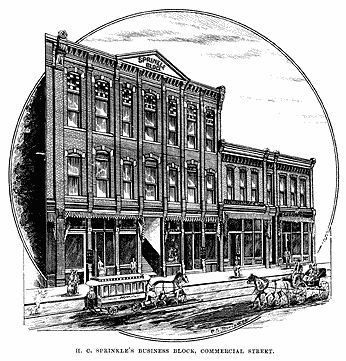SPRINGFIELD, MISSOURI AND SURROUNDINGS • 1889
(previous page) the chief ministries to their health, comfort and permanent prosperity. The official roster of the company embraces P. B. Perkins, President; John Francis, Vice President, and W. C. Hornbeak, Secretary, Treasurer and General Manager. The management of this system is alike complimentary to the company and the city and reflects high credit upon Mr. Hornbeak and his official associates, who are among the most progressive, public spirited and thoroughly executive men of the city. Springfield is pre-eminently THE CITY OF SCHOOLS. From early to late, its cultivated and progressive people, have been earnest and successful workers for free popular education. A strong enlightened and growing school sentiment pervades all classes and the result is seen in nine handsome and commodious public school buildings, an admirable school system, a model high school, an enrollment of 4,200 pupils, a high order of discipline, and a reputation for scholarship second to no public schools in the West. DRURY COLLEGE affords facilities for higher academic culture to be found nowhere else in Southwest Missouri. It has a group of fine massive college buildings, located in a beautiful campus of nearly forty acres in the heart of the city, and, environed with charming groves, ample deeply shaded lawns, spacious parade grounds, delightful walks and drives, and all the accompaniments of a magnificent park, is the embodiment of a model college home, and by far the most attractive feature of the city. Drury College is not a mere boys and girls school of local and provincial cast, but an institution of high grade for ladies and gentlemen, whose elegant buildings and grounds, generous endowment, large and cultivated faculty, liberal and comprehensive curriculum, fine library and scientific collections, and able and progressive management, give it rank with the foremost institutions of the country. It is founded on the broad and rational plan of co-education of the sexes, and carries upon its rolls a splendid company of young ladies and gentlemen, representing a dozen states and territories, whose rank, standing and opportunity are measured by conduct and scholarship rather than by sex. Preparatory and Biblical departments, full classical and scientific courses, a department of art, conservatory of music, gymnasium, literary societies, and a school for military training, the latter managed by a company of cadets, and the charming social order at Fairbanks Hall, the young ladies’ home, give the Drury College student advantages for social, moral, intellectual and physical training unsurpassed by even the great State universities. The school fairly represents the advanced educational sentiment and culture of the Southwest, and has a future of usefulness and honor co-extensive with this great region. The cost of an education here is very cheap, by comparison with other leading colleges, $150 being quite suflicient for the expenses of the college year to young men, and from $190 to $210 per year for young ladies who avail themselves of the pleasures and comforts of Fairbanks Hall. The citizens of Springfield, many of whom have been educated at Drury, are proud of this noble institution, which, from the date of its founding in 1878, has done more for the social and intellectual advancement of the community and the attraction of refined and intelligent people to the city, than all other agencies combined.
A young ladies seminary of high repute, a Catholic academy under the supervision of the Sisters of Loretto, a well-known commercial college and the Missouri Academy of Music, with several parochial, mission and private schools, are each and all educational agencies worthy of this beautiful and growing metropolis. The city has THIRTY-SIX CHURCHES and a dozen missions and chapels, representing nearly every phase of religious thought and life, and there is hardly a secret order, union or fraternity, not fully represented by the fifty-seven societies now organized within its limits. There are several social and literary clubs, representing the more independent, ambitious and intelligent elements of the city. THE PERKINS GRAND OPERA HOUSE, a theatre, two music halls, and half a dozen private halls and pleasure resorts, afford the amplest opportunity for social, intellectual, musical and dramatic entertainment. The Perkins Grand Opera House, completed and furnished in the spring of 1888, by P. B. Perkins, at a cost of $75,000, has a seating capacity of 1400, and for the completeness, elegance and perfection of its finish and appointments, ranks with the finest opera houses in the West. It is modern in every detail, and a compliment to its public spirited builder and the city. Prominent among the agencies for the advancement of the city, are the BOARD OF TRADE and Merchants’ Exchange, both recruited from the ranks of the influential business men of the (next page)
Page
1 | 2 | 3 | 4 | 5 | 6 | 7 | 8 | 9 | 10 | 11 | 13 | 14 | 15 | 16 | 17 |
18 | 19 | 20 | 21 | 22 | 23 | 24 | 25 | 26 | 27 | 28 | 29 | 30 | 31 | 32 | 33 | 34 | 35
Springfield 1889 Home | Keyword Search | Engravings Thumbnails | Local History Home


